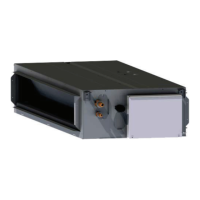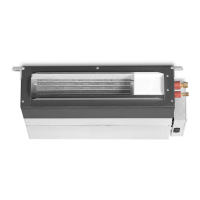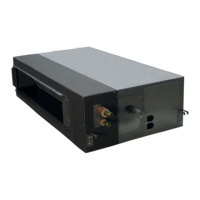7 Test run
244
SMGB0077 rev.0 - 01/2013
7.1 Checks prior to the test run
• Once installation is complete, carry out the test run in line with the procedure described below. The system can be
handed over to the client once the test has been correctly completed.
• Prior instructions to carry out the test run:
1 Verify the check points described in Check points.
2 Carry out the check procedure described in Check procedure.
3 Carry out the test run on the indoor units individually and in order.
4 Check that the wiring and refrigerant piping connections are connect.
5 Start the indoor units individually and in order. Check that they are correctly numbered.
6 Carry out the test in line with the instructions given in section Test procedure using the remote control.
C A U T I O N
• Bear the following in mind while the system is running:
1 Do not touch any component in the discharge gas area. The compressor chamber and the piping are at tempe-
ratures of over 90°C. They may cause burns.
2 Do not touch the magnetic breakers. This could cause a serious accident.
• Wait for more than three minutes before touching electrical components after turning off the main switch.
• Check that the gas and liquid line stop valves are fully open.
7.1.1 Check points
• Do not start the system until all of the check points have been veried.
1 Use a multimeter to measure the resistance between earth and the electrical component terminal. Check that the re-
sistance is above 1 MΩ. Otherwise, do not start the system, locate the electrical leak and repair. Do not apply voltage
to transmission terminals 1 and 2.
2 Check that the outdoor unit stop valves are fully open. If so, start the system.
3 Check that the power supply switch has been on for over 12 hours to heat up the compressor oil.
7.1.2 Check procedure
Check:
1 The gas and liquid line stop valves are fully open.
2 That there are no refrigerant leaks.
N O T E
Flare nuts may sometimes loosen due to vibrations during transportation.
3 Refrigerant piping and wiring form part of the same system.
4 The number of the DSW1, DSW6 and RSW1 units corresponds to the system.
5 The setting of the DIP switches on the printed circuit board of the indoor units is correct. Pay particular attention to the
set different in height between the indoor and outdoor units. See the wiring diagrams for further details.
6 The power supply switch has been on for over 12 hours to heat up the compressor oil.
7 The wiring is correctly connected. See the wiring diagrams for further details.
8 Each terminal (L1, L2, L3, N or L1 and N) is correctly connected to the power supply.
9 The eld-supplied electric components (main power switch protection fuse, circuit breaker without fuse, residual current
breaker, wires, piping connectors and wire terminals) have been selected correctly in line with the electrical data given
in the technical catalogue and in national and local regulations.
10 The power supply wiring terminal connection (L1 to L1 and N to N). Check the connection of the terminal boards run-
ning at 380 Vac. An incorrect connection may damage components.
11 Intermediate wire terminals between the indoor unit (operational line: terminals of every terminal board for 12 V) t
correctly. An incorrect connection may damage components.
12 The crankcase checker has been on for more than four hours. The device will not work unless it has been on for more
than four hours.

